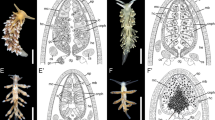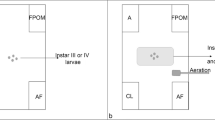Abstract
Aeolid nudibranchs maintain functional nematocysts, which are sequestered from the nudibranchs’ cnidarian prey and provide protection against predators. Some species exhibit extensive variation in incorporated nematocysts, while others maintain a limited number of types. This study examines the apparent diversity in uptake and patterns of nematocyst incorporation among related species. Nematocyst complements were described for four Gulf of Maine nudibranch species in the genus Flabellina exhibiting a variety of feeding strategies and prey specificities. Diet manipulations were performed to examine the response to changing nematocyst availability using a generalist consumer, Flabellina verrucosa, to assess nematocyst uptake based on diet. The flabellinid species examined exhibited significant differences in nematocyst incorporation, reflecting differences in their specificity as predators and nematocyst types available in their natural prey. The nematocyst complement of F. verrucosa was the most variable and differed among collection regions. When diet was manipulated, nematocyst uptake depended on the prey the nudibranchs consumed, but when offered a variety of prey, F. verrucosa selectively preferred nematocysts from scyphistomae. The observed variation in nematocyst uptake among species and regions probably relates to environmental disparities among populations.






Similar content being viewed by others
References
Bleakney JS (1996) Sea Slugs of Atlantic Canada and the Gulf of Maine. In: Lucy S (ed) Nimbus Publishing and the Nova Scotia Museum, Halifax, Nova Scotia
Calder DR (1988) Shallow-water hydroids of Bermuda: the Athecatae. In: Barlow JD, Hawken JE (eds) Life sciences contributions, vol 148. Royal Ontario Museum, Toronto, Canada, pp 1–107
Conklin EJ, Mariscal RN (1977) Feeding behavior, ceras structure, and nematocyst storage in the aeolid nudibranch, Spurilla neapolitana (Mollusca). Bull Mar Sci 27:658–667
Day RM, Harris LG (1978) Selection and turnover of coelenterate nematocysts in some aeolid nudibranchs. Veliger 21:104–109
Edmunds M (1966) Protective mechanisms in the Eolidacea (Mollusca, Nudibranchia). J Linn Soc London, Zool 46:46–71
Frick K (2003) Response in nematocyst uptake by the nudibranch Flabellina verrucosa to the presence of various predators in the southern Gulf of Maine. Biol Bull 205:367–376
Greenwood PG, Garry K, Hunter A, Jennings M (2004) Adaptable defense: a nudibranch mucus inhibits nematocyst discharge and changes with prey type. Biol Bull 206:113–120
Grosvenor GH (1903) On the nematocysts of aeolids. Proc R Soc Lond 72:462–486
Harris LG (1973) Nudibranch associations. In: Cheng TC (ed) Current topics in comparative pathobiology. Academic, New York, pp 213–315
Hernroth L, Gröndahl F (1985a) The biology of Aurelia aurita (L.): 3. Predation by Coryphella verrucosa (Gastropoda, Opisthobranchia) a major factor regulating the development of Aurelia populations in the Gullmar Fjord, western Sweden. Ophelia 24(1):37–45
Hernroth L, Gröndahl F (1985b) On the biology of Aurelia aurita (L.): 2. Major factors regulating the occurrence of ephyrae and young medusae in the Gullmar Fjord, western Sweden. Bull Mar Sci 37(2):567–576
Jablonski D (1986) Larval ecology and macroevolution in marine invertebrates. Bull Mar Sci 39(2):565–587
Kepner WA (1943) The manipulation of the nematocysts of Pennaria tiarella by Aeolis pilata. J Morphol 73:297–311
Kuzirian AM (1979) Taxonomy and biology of four New England coryphellid nudibranchs (Gastropoda: Opisthobranchia). J Moll Stud 45:239–261
Mariscal RN (1974) Nematocysts. In: Muscatine L, Lenhoff HM (eds) Coelenterate biology: reviews and new perspectives. Academic, New York, pp 129–178
Martin R (2003) Management of nematocysts in the alimentary tract and in cnidosacs of the aeolid nudibranch gastropod Cratena peregrina. Mar Biol 143:533–541
McDonald GR, Nybakken JW (1996) A list of the worldwide food habits of nudibranchs. http://people.ucsc.edu/~mcduck/nudifood.htm. Accessed 11-8-04
Meyer KB (1971) Distribution and zoogeography of fourteen species of nudibranchs of northern New England and Nova Scotia. Veliger 14(2):137–152
Miller JA, Byrne M (2000) Ceratal autotomy and regeneration in the aeolid nudibranch Phidiana crassicornis and the role of predators. Invert Biol 119:167–176
Morse MP (1969) On the feeding of the nudibranch, Coryphella verrucosa rufibranchialis, with a discussion of its taxonomy. Nautilus 83(2):37–40
Östman C (1997) Abundance, feeding behavior and nematocysts of scyphopolyps (Cnidaria) and nematocysts in their predator, the nudibranch Coryphella verrucosa (Mollusca). Hydrobiologia 355:21–28
Wright TS (1863) On the cnidae or thread cells of the Eolidae. Proc R Soc Edinb, sessions 2858–2859, 1859–1860, 1860–1861
Acknowledgements
Support, space, and funding from the University of New Hampshire enabled the completion of this project. Dr. Larry Harris supported both the ideas and research for this work, and provided comments on drafts of this paper, along with reviewers for this journal and the Northwest Fisheries Science Center. Specimen collection could not have been completed without help from Rebecca Toppin and Glen Rice. Additional comments from Lauralyn Dyer and Jennifer Dijkstra improved the experimental design. This research was supported by funds from the University of New Hampshire Center for Marine Biology; the National Sea Grant College Program of the National Oceanic and Atmospheric Administration, under grant number NA56RG0159; and by additional funds provided by the Open Ocean Aquaculture project component of the NOAA UNH Cooperative Institute for New England Mariculture and Fisheries (CINEMAR), NOAA grant number NA16RP1718. These experiments comply with the current laws of the United States of America.
Author information
Authors and Affiliations
Corresponding author
Additional information
Communicated by P. W. Sammarco, Chauvin
Rights and permissions
About this article
Cite this article
Frick, K.E. Nematocyst complements of nudibranchs in the genus Flabellina in the Gulf of Maine and the effect of diet manipulations on the cnidom of Flabellina verrucosa . Marine Biology 147, 1313–1321 (2005). https://doi.org/10.1007/s00227-005-0034-1
Received:
Accepted:
Published:
Issue Date:
DOI: https://doi.org/10.1007/s00227-005-0034-1




